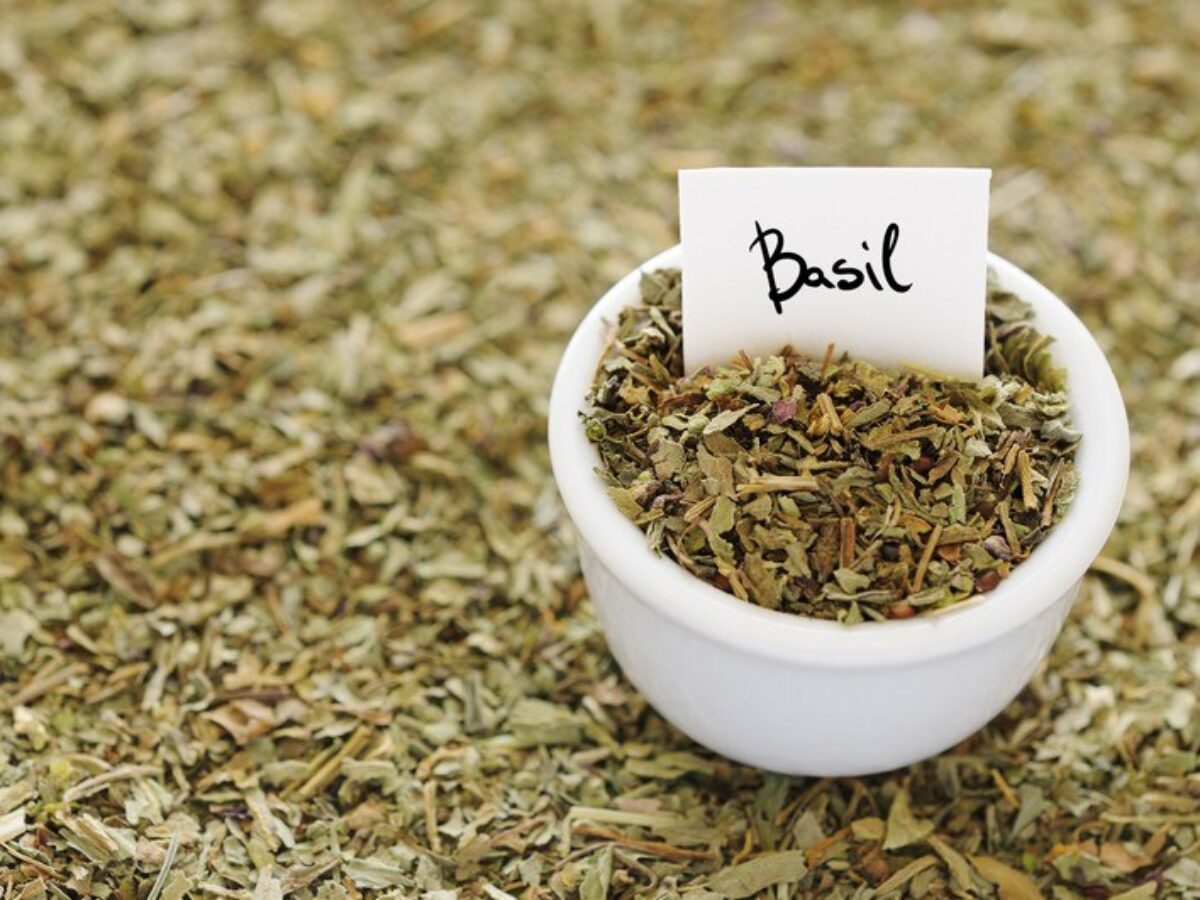Basil Ocimum basilicum Dried Leaves in bulk packaging shipped in 20″ FCL container
Login to view prices
Common names: basil, French basil, or sweet basil (English); basilic (French); basilikum, basilienkraut (German); tulsi (Indian); basilico (Italian); albahaca (Spanish); Raihan (Arabic).
Latin name: Ocimum basilicum L
Family: Lamiaceae (Labiatae)
Basil is cultivated commercially for its green, aromatic leaves, which are used fresh or dried as a flavoring or spice. The essential oil and oleoresin are extracted from the leaves and flowering tops via steam distillation and used in place of the dried leaves for flavoring purposes.
The common sweet basil (Ocimum basilicum), with its several types and varieties, is an annual aromatic plant, widely grown because of its pleasant spicy odor and taste. There are large and dwarf types with green, purple, or variegated leaves, some of which are ornamental. Both the leaves and the essential oils distilled from the flowering plants are used as flavoring agents.
Botanical Origin:
Common names: basil, French basil, or sweet basil (English); basilic (French); basilikum, basilienkraut (German); tulsi (Indian); basilico (Italian); albahaca (Spanish); Raihan (Arabic).
Latin name: Ocimum basilicum L
Family: Lamiaceae (Labiatae)
Basil is cultivated commercially for its green, aromatic leaves, which are used fresh or dried as a flavoring or spice. The essential oil and oleoresin are extracted from the leaves and flowering tops via steam distillation and used in place of the dried leaves for flavoring purposes.
The common sweet basil (Ocimum basilicum), with its several types and varieties, is an annual aromatic plant, widely grown because of its pleasant spicy odor and taste. There are large and dwarf types with green, purple, or variegated leaves, some of which are ornamental. Both the leaves and the essential oils distilled from the flowering plants are used as flavoring agents.
Description:
The flowers are borne in long terminal racemose inflorescences. The greenish corolla is small and inconspicuous. The calyx, partly grown together with bracts, enlarges itself postflorally and remains with the latter dry on the plant.
Many varieties of sweet basil exist with the curly leafed variety is said to give the best yield of the oil and, incidentally, of the finest quality. The curly leafed variety is said to give the best yield of oil and, incidentally, of the finest quality.
Range & Habitat:
The world market for basil oil is dominated by two main types, the European and Egyptian basil oils.
- The European sweet basil, cultivated and distilled in Europe, the Mediterranean region, and the United States is considered to be of the highest quality, producing the finest odor. Characteristically, the essential oil from this basil contains high concentrations of linalool and methylchavicol (estragole), at a ratio of 2 or 3:1. Other constituents found in low concentrations include: 1,8-cineole, eugenol, alpha-terpeniol, beta-caryophyllene, geraniol, sabinene, alpha-phellandrene, gamma-terpinene, thujone, myrcene, limonene, ocimene, and para-cymene.
- The Egyptian basil oil is very similar to the European but with a higher concentration and ratio of methylchavicol relative to linalool.
Other distinct types of basil oil traded on the international market and which differ in aroma include:
- The Comoro (also called Reunion or African basil oil), originally distilled only on Reunion Isle but now grown and distilled throughout many parts of Africa, Madagascar, and the Seychelles Islands which has a licorice and or camphoraceous fragrance. The main constituent of this basil oil is methylchavicol, with camphor sometimes present, but little if any linalool, alpha-pinene, eugenol, or 1,8-cineole.
- Methylcinnamate-rich basil (or cinnamon basil oil) has been commercially produced in Bulgaria, India, Guatemala and Pakistan, is also traded as a natural source of methyl cinnamate.
Ecology:
Sweet basil is cultivated in agro-climes between 7 to 27°C, with 0.6 to 4.2 m annual precipitation and soil pH 4.3 to 8.2. The tender herbaceous annual, which is susceptible to frost and cold-temperature injury, develops best under long days, in full sun, and well-drained soils.
Planting, Cultivation:
- Planting:
Basil can be direct seeded or transplanted to the fiield in late Spring after all danger of frost has passed. The germination rate of the seed should be above 80 %. If the soil is heavy, an anticrustant may be used. Soil should be kept moist to hasten germination and to improve stand establishment. Seeds are small and should be planted shallow (ca.0.3 cm).
Commercially, an onion seeder will sow basil effectively. Seedbed should be friable, well-tilled and uniform. Emergence occurs after 8-14 days. Initial growth is slow, but after a few sets of leaves have emerged, growth rate increases significantly. Most small growers raising basil as an annual crop for the fresh market use transplants, rather than direct field sowing. Transplants are easy to produce and normally require 4-6 weeks of growth.
Lateral branching and growth may be encouraged by topping when plants are about 12 cm in height. Optimum population density is in part dependent upon end use; high density can be used if compatible farm equipment are available for mechanical cultivation and harvesting.
- Population and Spacing:
Rows 60 to 90 cm apart, with plants spaced every 15 cm. are commonly used. Basil can also be planted in raised beds of three rows, 30 cm. apart between rows. Distance between beds is dependent on grower’s equipment, and generally range from 24 to 36 inches.
Large variations in growth and yield should be expected due to climatic conditions, plant types, and cultural and management practices.
- Fertilization:
Fertilizer applications depend upon soil type, cropping history. Basil responds well to moderate fertility, and a N-P2O5-K2O ratio of 1-1-1 can be used successfully, with an N rate of 230-300 kg of actual N/ha applied as a broadcast and plow down. Nitrogen side dressing at rates of 50-75 kg actual N/ha is suggested following each harvest.
- Irrigation:
Basil is intolerant to water stress at any stage of development. A regular and even supply of water at rates used for most herbaceous vegetable crops will provide ample water.
- Weed control:
There are no national or state herbicide registrations for basil in the USA. This means that basil must be grown without herbicides. If basil is imported and sold for consumption in the USA it must be free of herbicide residues. As such, mechanical cultivation, high plant populations, use of mulch and manual weeding are among the choices for weed control. The presence of weeds in fresh, dry or processed basil leaves can decrease the quality of the finished product.
- Insects and Diseases:
There are several insects and diseases that may infest basil, including fusarium, but there are no pesticides currently available for use on basil. Plants should therefore be monitored continually for the presence of insects and diseases.
Harvesting and preparing for the market:
The plant part harvested depends upon the projected use. Where basil is grown for its dried leaves and the extraction of essential or volatile oil, it is cut just prior to the appearance of flowers. In the Mediterranean area and in other countries with similar climates, basil is grown as a short-lived perennial, and 3-5 cuttings or harvests per year are achieved. In the more temperate zones basil may be cut only 1-3 times. The first harvest in this case is very low, and the second occurs just prior to open bloom. Generally, basil is harvested for its leaves, sold fresh or dried. The foliage should be harvested, but only above the bottom two to four sets of true leaves.
A sickle bar gerry mower with an adjustable cutting height can be employed to cut the herb. Leaves can be harvested when needed. The foliage should be cut at least 4-6 inches above the ground to allow good second crop.
To ensure a continuous supply of leaves, the field harvests and/or planting dates can be staggered accordingly.
- Post-Harvest Handling
For Fresh Market:
Leaves should first be washed and cleaned, with weeds and extraneous materials removed. The quality of basil is determined by color and aroma retention. For the fresh market, only the highest quality plant material should be sold. Prior to milling, the leaves and/or flowering tops should be dried at low temperatures (below 40° C) to retain maximum color.
For Distillation:
After cutting the herb may be allowed to lie in the sun and wilt for 2 or 3 hr., to facilitate packing in the distilling vats, but prolonged drying may affect the quality of the oil. The wilted herb may be raked into windrows with a hay rake and hauled immediately to the distillery, where it should be firmly packed into the distilling vats.
Export Markets:
We export our products to many countries all over the world. USA, France, Germany, China, Malaysia, Algeria, Morocco, Indonesia…etc
Quotation:
- Incoterms: FOB
- Quantity: one 20″ FCL Container Minimum
- Specification: 100% natural and Pure quality
- Documentation: COA, MSDS, TDS, GC Peaks
- Packaging: Bulk Packaging
- Payment terms: TT in advance to Our bank account
- Lead time: Shipping through 10 days from receipt of the payment.
- Sea Shipping Time: 35 days
- Air shipping time: 10 days
Quality Certificates:
- ISO 9001-2015
- ISO 22000-2005
- GMP accredited by AQC Middle East FZE
- KOSHER Certificate
- Halal Certificate
- ORGANIC Certificate accredited by CERES GmbH Germany
- NOP Certificate accredited by CERES GmbH Germany
- Egyptian Ministry of Health Permission
Contact us please to receive other supporting documents for our Oils :
- COA
- MSDS
- TDS
Branding Services
We also can do customized packaging for you to pack whatever size you like. We can help in designing labels, selecting good packets or bags. We deliver integrated solutions under your brand..
Organically Certified product Available upon request
Additional information
| Weight | 12000 kg |
|---|---|
| Dimensions | 610 × 244 × 259 cm |
| Country of Origin | Egypt |
| Ship from | Egypt |
| 20 Container Capacity H | 5500 kg |
| Herbal Part Types | Crushed leaves Large cut, Dried Whole Leaves, Crushed leaves Medium cut, Crushed leaves small cut, Powder |
| Herbs Packaging | PE bags 25 Kg, PE Bags 50 kg, Paper Bag 25 kg, Paper Bag 50 kg |
| Cultivation Type | Organic, Conventional |
| HS Code | 09109990 |
| Custom Branding & Packaging | Yes, OEM Custom banding, designing and packaging are available for that product |
| Herbal OEM Packaging | Kraft Bag, Kraft Bag with transparent window, Kraft bag with open side, Glass Jar, Glass jar Spices with holed lid, Tea bag, Tea bag with paper bag, Tea Cylinder packaging, Tin Packaging |
| Documentation & Certifications | Allergen Free Certificate, Bovine Spongiform Encephalophathy (BSE) Certificate, GMO Certificate, GRAS Status Statement, Herbal Origin Statement, Organic Certificate, Pesticide Residual Certificate, Halal Certificate, KOSHER Certificate, Researches & Studies, Certificate of Analysis (COA), Technical Data Sheet (TDS) |
-
Login to view prices
-
Login to view prices
Dill Seeds Anethum graveolens in Bulk packaging Shipped in 20″ FCL Container
Login to view prices Read more -
Login to view prices
Dehydrated Bell Sweet Pepper Paprika Capsicum annuum in bulk packaging
Login to view prices Read more





